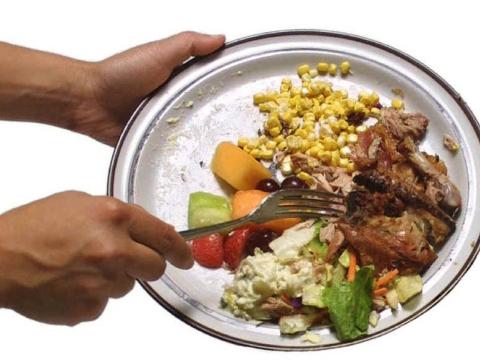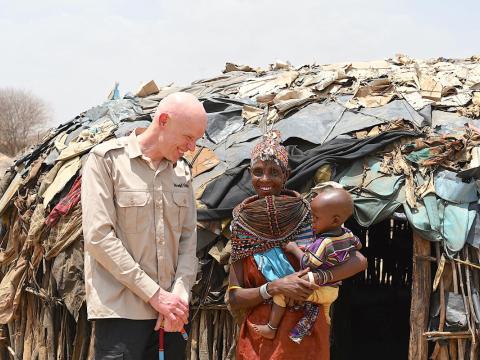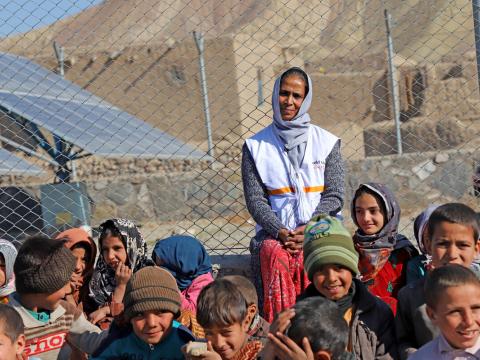
Food waste means the Earth’s loss
On International Day of Food Loss and Waste, James East reflects on the link between wasting food and the devastating impact on our planet.
29 September, 2022
When I was a kid, my parents would ‘persuade’ me to eat everything on my plate by reminding me that "children in Africa were starving" and would be glad to have my food. Guilt was an effective way of getting me to eat my vegetables, but it was also a way for mum and dad to remind me how fortunate I was to be eating at all.
It was also a way for them to prevent me wasting food. My parents had grown up during World War Two experiencing their own privations, including the rationing of most food. Being frugal was part of their DNA. Their comments about hungry children overseas rang true, not least because I was growing up in the 1960s when images of Nigeria’s Biafran war were on our television, showing thousands of children starving and aid agencies fundraising to help.
I am reflecting on my childhood meal times because the 29th of September is International Day of Awareness of Food Loss and Waste. Yes, I’d never heard of it either until a colleague shared some gobsmacking stats from 2021’s Food Waste report. That report showed, not just how much food was being scraped from plates into bins, but how much was wasted all the way along the food supply chain.
An unbelievable one third of food is lost on the journey from harvest to retail and during consumption. This is happening as 50 million people around the world face famine, and when war – this time in Ukraine – is once again impacting food supply chains.
A couch-worth of waste
As an eager composter, I’m keenly aware of how much food is being wasted by my own family. We typically fill half an outdoor compost bin with food scrapings each year. On average though, each person wastes 74 kilograms of food a year at home – the equivalent of a four-seater couch in weight. A sixth of our household food is chucked either because it’s past its use-by-date, we can’t eat all that’s on our plate, or we just don’t like it.
When one adds up this global waste, family by family, country by country, and factor in the massive food losses generated by the agriculture, transport and packaging sectors, the environmental impact is staggering. Food loss and waste accounts for 8-10 % of global greenhouse gases, contributing to the warming of our world, and making it ever harder for farmers to grow those crops in the first place.
Around the world the seasons are getting messed up. Drought follows drought in East Africa where some 12 million people face starvation. Floods worsened by accelerating glacial melt are creating super floods like that which has inundated one third of the Pakistan, devastating crop lands and leaving 33 million people destitute.
Two causes for food wastage
Food waste is prevalent for two reasons. Around the world, incomes have grown making food relatively cheaper to billions of people. Even meat, once a luxury, has become an everyday food item. In the UK, between 1957 and 2017 the share of household expenditure spent on food halved. People’s relationship with food has changed. It’s easy to buy, cook and throw away.
Food is also cheaper to produce. Vast areas of the earth have been given over to agriculture: ancient forests torn down for beef farms and palm oil plantations; hedges ripped up to create huge fields of wheat; mangrove forests decimated for shrimp farms. The sea too plundered by ships armed with nets that are kilometres long. Large-scale faming using genetically modified seeds, monoculture farming, massive mechanised agricultural equipment, and the use of fertilisers and pesticides have made farming more ‘efficient’ but at great cost to the earth. They have also left the world overly dependent on places like Ukraine – the so-called breadbasket of the world – for grain supplies.
But the impacts of climate change; the knock-on effects of conflict in Ukraine on energy and food prices; and the aftershocks of COVID-19 on supply chains has shown how vulnerable the food supply system is. Recent months of food shortages and price spikes are reminding us of the value of the food we eat.
What can be done?
Cutting food waste requires three things.
The first is a personal choice. We can reduce the amount we eat and throw in the bin. We can be more careful how much we buy, turning down tempting three-for-two supermarket offers that simply lead us to throw food away. We can cut snacking and plan meals better. We can buy fresh, local and seasonal food, reducing the amount of fruit and veg transported across the world. We can cut back on processed foods that generate so much food waste and mountains of plastic packaging.
Secondly, food growers, producers, retailers and transporters must take action to reduce waste. The combined impact of food processing and packaging, transport and food waste, is pushing the food supply chain to the top of the list of carbon emitters globally. And yet, some 14% of the world's food is lost between harvest and retail. Food waste, rotting in landfills, generates methane, a potent greenhouse gas with 84 times the warming power of carbon dioxide over 20 years. Crop over-production, transport spoilage, food dumping, the throwing out of blemished or misshaped ‘ugly’ produce, and the disposal of unsold or out-of-date items by retailers all need to be aggressively tackled.
Lastly, governments need to track food waste and work with citizens, corporations and countries to reduce it. Countries have promised to halve global food waste by 2030 as part of the Sustainable Development Goals. With eight years to go there is much to do. Poorer nations also need support to improve their own food supply chains. Incredibly sub-Saharan Africa – currently in the grip of a massive hunger crisis – has one of the highest rates of food wastage in the world. Some 21.4% of all food is lost and wasted on its supply chain journey from farm to retail. All countries need to identify waste hotspots where improvements must be made.
While it’s tempting to use the same guilt technique my parents applied at mealtimes with my own teens, I believe dinner time is also an opportunity to discuss food: where it comes from, how it gets to our table, and the environmental impacts of that journey – all while appreciating the wonders of food and what meals mean to us.
- Read the news release from World Vision calling for action to reduce food waste here.
- Learn more about World Vision’s efforts to address the impact of the climate crisis on children here and the hunger crisis here
James East leads emergency communications for World Vision International and is dad to two hungry teenagers.


